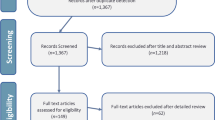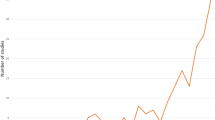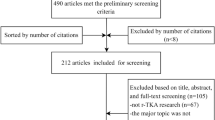Abstract
Purpose
Robotic-assisted unicompartmental knee arthroplasty (UKA) has gained popularity over the last decade claiming enhanced surgical precision and better joint kinematics, with peer-reviewed publications about this new technology also increasing over the past few years. The purpose of our study was to compare manuscripts about robotic-assisted UKA to those about standard UKA in terms of industry funding, author conflict of interest, scientific quality, and bibliometrics.
Methods
A systematic search using PRISMA guidelines on PubMed and Google Scholar from 2012 to 2016 resulted in 45 papers where robotic technology was performed for UKA and 167 papers that UKA were performed without the assistance of a robot. Between the two groups, we compared (1) rate of manuscripts with reported conflict of interest or industry funding, (2) journal impact factor, (3) level of evidence, and (4) relative citation ratio.
Results
Fifty-one percent (23/45) of robotic UKA manuscripts were industry-funded or had authors with financial conflict of interest, compared to 29% ([49/167], p < 0.01) of non-robotic UKA papers. Significantly more robotic UKA papers (24% [11/45] vs 9% [16/167), p < 0.01) were published in journals that were not assigned an impact factor by the Journal Citations Report. There was no difference in regard to bibliometrics or level of evidence.
Conclusion
Manuscripts in which UKA was performed with the assistance of a robot were more likely to be industry funded or be written by authors with financial conflicts of interest and published in less prestigious journals. There were no differences in scientific quality or influence between the two groups. Readers analyzing published data should be aware of the potential conflicts of interests in order to more accurately interpret manuscripts data and conclusions.



Similar content being viewed by others
References
Jacofsky DJ, Allen M (2016) Robotics in arthroplasty: a comprehensive review. J Arthroplast 31:2353–2363. https://doi.org/10.1016/j.arth.2016.05.026
Lonner JH, Moretti VM (2016) The evolution of image-free robotic assistance in unicompartmental knee arthroplasty. Am J Orthop 45:249–254
Herry Y, Batailler C, Lording T et al (2017) Improved joint-line restitution in unicompartmental knee arthroplasty using a robotic-assisted surgical technique. Int Orthop 41:2265–2271. https://doi.org/10.1007/s00264-017-3633-9
Bell SW, Anthony I, Jones B et al (2016) Improved accuracy of component positioning with robotic-assisted unicompartmental knee arthroplasty: data from a prospective, randomized controlled study. J Bone Joint Surg Am 98:627–635. https://doi.org/10.2106/JBJS.15.00664
Goldberg BA, Scarlat MM (2017) No free lunch in orthopedics. Int Orthop 41:1963–1964. https://doi.org/10.1007/s00264-017-3642-8
Foughty Z, Antalis MS, Ringenberg J, Hall AD (2017) Funding sources and financial disclosures, and their relationship to study outcomes and level of evidence in the journal of shoulder and elbow surgery. J Shoulder Elb Surg 26:e193–e197. https://doi.org/10.1016/j.jse.2017.02.016
Moher D, Liberati A, Tetzlaff J et al (2009) Preferred reporting items for systematic reviews and meta-analyses: the PRISMA statement. PLoS Med 6:e1000097. https://doi.org/10.1371/journal.pmed.1000097
Marx RG, Wilson SM, Swiontkowski MF (2014) Updating the assignment of levels of evidence. J Bone Joint Surg Am 97:1–2. https://doi.org/10.2106/JBJS.N.01112
Okike K, Kocher MS, Mehlman CT, Bhandari M (2007) Conflict of interest in orthopaedic research. An association between findings and funding in scientific presentations. J Bone Joint Surg Am 89:608–613. https://doi.org/10.2106/JBJS.F.00994
Friedman LS, Richter ED (2004) Relationship between conflicts of interest and research results. J Gen Intern Med 19:51–56
Fischgrund JS (2012) Conflict of interest in orthopaedic journals. J Am Acad Orthop Surg 20:263–264. https://doi.org/10.5435/JAAOS-20-05-263
Wright JG, Swiontkowski MF, Heckman JD (2003) Introducing levels of evidence to the journal. J Bone Joint Surg Am 85-A:1–3
Scheschuk JP, Mostello AJ, Lombardi NJ et al (2016) Levels of evidence in orthopaedic trauma literature. J Orthop Trauma 30:362–366. https://doi.org/10.1097/BOT.0000000000000557
Zaidi R, Abbassian A, Cro S et al (2012) Levels of evidence in foot and ankle surgery literature: progress from 2000 to 2010? J Bone Joint Surg Am e112(1–10):94. https://doi.org/10.2106/JBJS.K.01453
Stringer MJ, Sales-Pardo M, Nunes Amaral LA (2008) Effectiveness of journal ranking schemes as a tool for locating information. PLoS One 3:e1683. https://doi.org/10.1371/journal.pone.0001683.s005
Hutchins BI, Yuan X, Anderson JM, Santangelo GM (2016) Relative citation ratio (RCR): a new metric that uses citation rates to measure influence at the article level. PLoS Biol 14:e1002541. https://doi.org/10.1371/journal.pbio.1002541
Greenwood DC (2007) Reliability of journal impact factor rankings. BMC Med Res Methodol 7:48–53. https://doi.org/10.1186/1471-2288-7-48
Lavoie F, Al-Shakfa F, Moore JR et al (2018) Postoperative stiffening after bicruciate-retaining total knee arthroplasty. J Knee Surg 31:453–458. https://doi.org/10.1055/s-0037-1604145
Turktas U, Piskin A, Poehling GG (2016) Short-term outcomes of robotically assisted patello-femoral arthroplasty. Int Orthop 40:919–924. https://doi.org/10.1007/s00264-015-2786-7
Lee H-J, Park Y-B, Song M-K et al (2018) Comparison of the outcomes of navigation-assisted revision of unicompartmental knee arthroplasty to total knee arthroplasty versus navigation-assisted primary TKA. Int Orthop 25:799–798. https://doi.org/10.1007/s00264-018-4028-2
Matta JM, Shahrdar C, Ferguson T (2005) Single-incision anterior approach for Total hip Arthroplasty on an Orthopaedic table. Clin Orthop Relat Res 441:115–124. https://doi.org/10.1097/01.blo.0000194309.70518.cb
Author information
Authors and Affiliations
Corresponding author
Ethics declarations
Conflict of interest
Dr. Cavinatto has nothing to disclose.
Dr. Bronson reports being member of the editorial board of the Journal of Arthroplasty and board member of the Arthritis Foundation.
Dr. Chen reports personal fees from Monogram Orthopedics, outside the submitted work.
Dr. Moucha reports personal fees from 3 M, personal fees from Biocomposites, outside the submitted work.
Rights and permissions
About this article
Cite this article
Cavinatto, L., Bronson, M.J., Chen, D.D. et al. Robotic-assisted versus standard unicompartmental knee arthroplasty—evaluation of manuscript conflict of interests, funding, scientific quality and bibliometrics. International Orthopaedics (SICOT) 43, 1865–1871 (2019). https://doi.org/10.1007/s00264-018-4175-5
Received:
Accepted:
Published:
Issue Date:
DOI: https://doi.org/10.1007/s00264-018-4175-5




